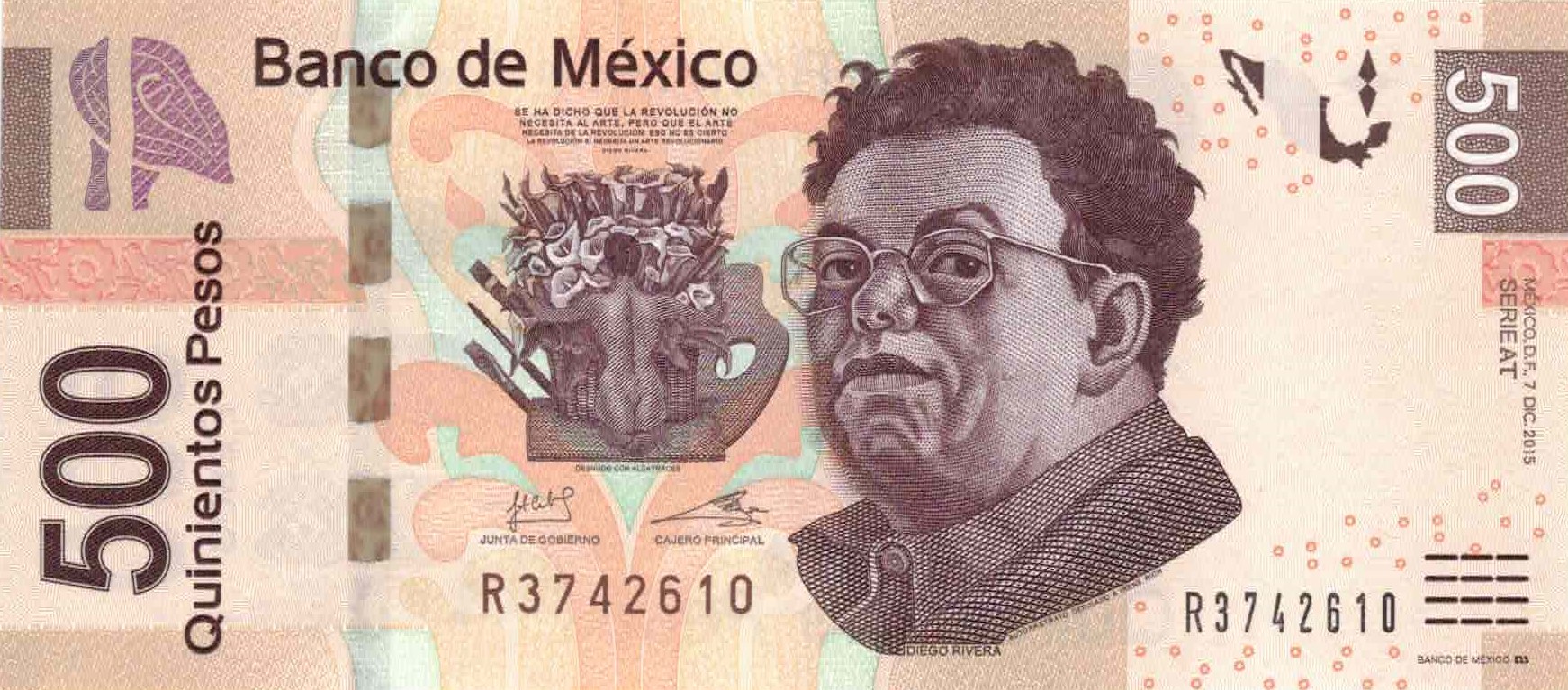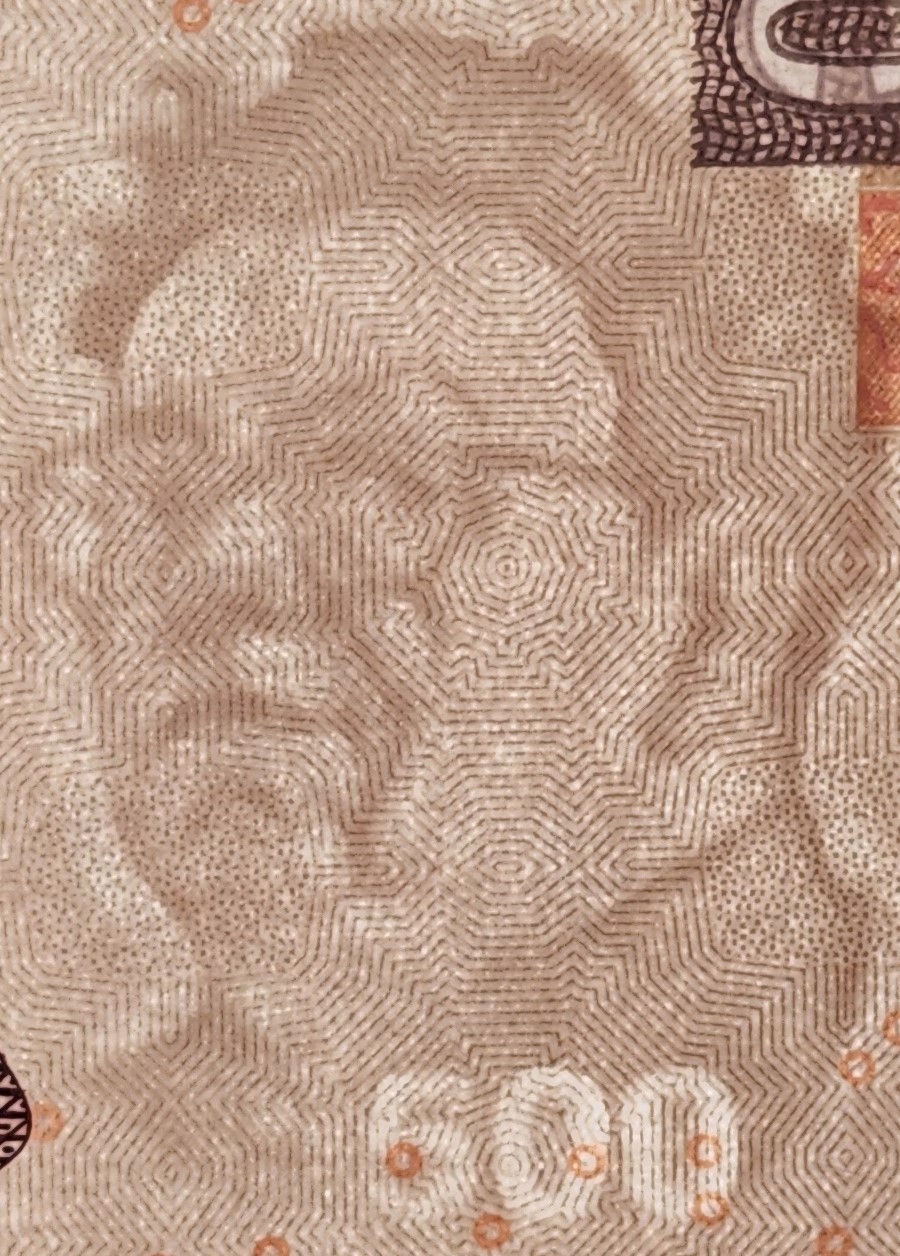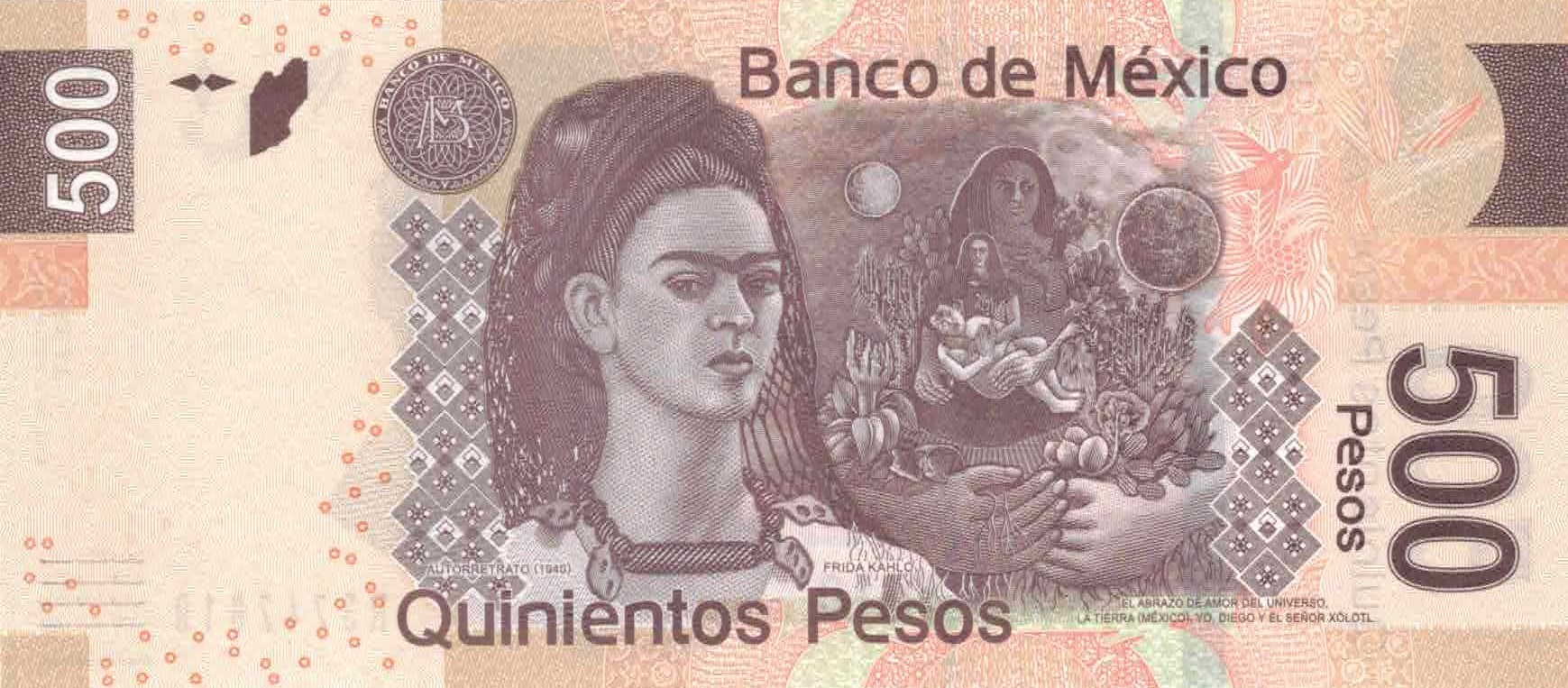Painting on a Mexican commemorative banknote,
or Frida Kahlo and Diego Rivera - always together.
Igor Kvyat, PhD (Rishon LeZion, Israel)
Beauty - and only a little bit of beauty,
the soul needs nothing more.
Lina Kostenko*.
Diego Rivera (1886-1957) and his wife Frida Kahlo (1907-1954) are two famous Mexican artists. He was 43 and still married when he met her, a 22-year-old student. They began a passionate affair. The former union broke up, and Diego and Frida started their family. The couple was brought together not only by art, but also by their common political passions, which were communist. Their tumultuous life together became legendary, their relationship consisted of love, adventures with other people, creative connections, hatred, divorce after 10 years of marriage, and a year later, their marriage again. However, we will also leave these details aside. Frida's and Diego's works influenced each other: folklore stories, cultural heritage, beliefs and customs of the peoples of Mexico are all themes in their works. He, the author of grandiose frescoes, a monumentalist painter who later gained worldwide fame, was inspired by the revolutionary movement in the country at the time. She painted numerous portraits, mostly self-portraits (she said that she painted them because, having been bedridden for a long time after an accident, she became the person she knew best). Inspired by the country's identity, Frida worked in the style of naïve art or primitivism and is considered a popicon of Mexican culture, one of the most prominent artists of the twentieth century. She lovingly called Diego her second accident... And he considered the day when Frida passed away to be the most tragic day of his life. Rivera died three years after her and was buried in Mexico City in the Rotunda of Eminent Persons. The Frida Kahlo House Museum is one of the most popular tourist and cultural sites in Mexico. The state has declared her works part of the national heritage, prohibiting their export abroad.
Artists and their masterpieces depicted on paper banknotes are quite common in the world. Let's mentally recall at least some of the big names: Leonardo da Vinci (1452-1519), Michelangelo (1475-1564), Raphael (1483-1520), Titian (1488/1490-1576), Caravaggio (1571-1610), Velazquez (1599-1660), Rembrandt (1606-1669), Delacroix (1798-1863), Aivazovsky (1817-1900), Cezanne (1839-1906), Pirosmani (1862-1918)... However, the appearance of banknotes depicting a husband and wife is a very rare event. Here we can recall a married couple of scientists, Nobel Prize winners Pierre (1859-1906) and Marie (1867-1934) Curie on the 500 French francs of 1994-2000, several royal couples of Belgium, Thailand, and Bhutan. That seems to be all... And, of course, Diego Rivera and Frida Kahlo.
On August 30, 2010, By introducing a 500 peso banknote with portraits of this married couple of artists, the Bank of Mexico completed the issue of another series of banknotes, started four years earlier, in the fall of 2006. The other banknotes depict: 20 pesos - Benito Juárez (1806-1872), the founder of modern Mexico, who repeatedly served as president of the state; 50 pesos - Jose Maria Morelos (1765-1815), a priest and rebel leader in the war of 1810-1821. 100 pesos - Nesahualcoyotl (1402-1472), philosopher and poet, one of the founders of the Aztec Empire; 200 pesos - Juana Inés de la Cruz (1651-1695), poet and philosopher, hermit nun; 1000 pesos - Miguel Hidalgo (1753-1811), priest and leader of the popular uprising that grew into the war for independence. The renewal of the banknote series was dedicated to the 200th anniversary of independence from Spanish rule and the centenary of the Mexican Revolution of 1910-1920. The "festive" 500 pesos began circulating in September 2010, just before the celebrations. At the same time, bills of the same denomination, introduced more than 15 years earlier, depicting the general and statesman Ignacio Zaragoza (1829-1862), remained in circulation.
Various activists believed that, compared to Kahlo and Rivera, Octavio Paz (1914-1998), one of the most prominent Spanish-language poets of the second half of the 20th century and winner of the 1990 Nobel Prize in Literature, would have been a more worthy candidate for the anniversary series. This denomination will be the highest in the country and will be issued whenever it is needed to meet the needs of users. According to financiers, this situation is not expected in the coming years.
Meanwhile, the obverse of our banknote features a self-portrait of Diego Rivera, in which the artist depicted himself in three quarters. He dedicated the oil painting to his close friend Irene Rich (1891-1988). On it, Diego holds a note in front of him (we were not shown it on the banknote), where he indicated that he painted a self-portrait in Santa Barbara, Southern California, in January 1941 for the famous and beautiful American actress Irene Rich. This work is now on display at the Smith College Museum of Art, an elite women's educational institution in Northampton, Massachusetts.

The artist painted not only murals but also "ordinary" oil and watercolor paintings. Each time, they feature different women to whom he was not indifferent. Diego painted them with unbridled enthusiasm in a special creative impulse. He compared the objects of his adoration to calla lilies, typical representatives of the lush flora of Mexico. His works are full of huge snow-white flowers that emphasize the attractive darkness and exquisite beauty of Mexican women. On the left side of the obverse, next to the portrait, we see one of them. This is "Nude with Feces," painted in the Art Deco style in 1944 in oil on organite. Today the painting is in a private collection.
On the banknote, three brushes and a palette are shown on either side of an elegant female figure depicted from the back. They represent the tools the artist used in his work. In the upper part of the obverse, one can read (though not easily - it is microtext) one of Rivera's most famous statements about revolution and art, which in a rough translation from Spanish sounds like this: "They say that revolution does not need art, and that art itself needs revolution. This is not true. Revolution is art."
On the reverse, the centerpiece is a self-portrait of Frida Kahlo with her head slightly turned to the right. Her face is focused and even looks stern. Indian on her mother's side and European on her father's, she combines pre-Columbian jewelry with a mantilla on her head (a piece of cloth that covers most of it and covers her hair), emphasizing the duality of her native country's and her personal origins. The work is titled "Self-Portrait Dedicated to Sigmund Firestone". American engineer Firestone commissioned self-portraits of Frida and Diego. She completed her work in February 1940, while Rivera, by the way, painted himself only the following year. In the inscription at the top right (not shown on the banknote), Frieda dedicates the self-portrait, as she emphasized, with love, to Sigmund and his two daughters, Natalia and Alberta. Created in oil on masonite in the style of naïve art, it is in a private collection owned by Violet Gershenson (New York). This self-portrait has received the greatest recognition from art historians and admirers of Kahlo's work.
Next to it is a reproduction of her painting The Loving Embrace of the Universe, the Earth (Mexico), Myself, Diego, and Señor Xolotl. We will not deny ourselves the pleasure of dwelling on it in a little more detail, because this work deserves exceptional attention. It contains several intertwining layers of embrace. First of all, we find a full-face self-portrait of the artist herself, who looks serious and worried, with tears streaming from her eyes (the printing quality of the banknote, unfortunately, is not high enough to see such details), and her hair is loose. In her arms is a baby with Diego's face. After the accident, Frida was unable to have children, and her husband became a big baby for her. He is naked, with a third eye on his forehead and a flame in his hands. This is a reference to a deity who is the embodiment of wisdom and intelligence. Frida regarded Diego as one of the most talented people in the world, often calling him a master, and admiring his art and way of thinking. However, she believed that she was more skillful as an artist. Both characters are embraced by an anthropomorphic female figure with a face reminiscent of Kahlo. This is the Earth (Mexico). A crack has appeared on her chest, from where mother's milk is pouring out. At the edge of the crack is a slightly upside-down tree, and on either side of the body is the vegetation of the Mexican desert. He is surrounded by a second female figure, the Universe, which forms a background with a dual position in space. To the left, the night merges with it - the moon is probably depicted there, above. The arm coming out of the figure on this side is dark. On the right side, the sun is shining - the figure is united with the day and its hand is light. Roots grow abundantly from both shoulders down the arms. In the right hand sleeps Scholocky Quintly, Frida's favorite dog, the very same Senor Xolotl. This richly symbolic work depicts a number of phenomena related to Frida's life difficulties, such as femininity, motherhood, and Diego Rivera himself. The painting was painted in 1949 with oil paints on canvas. Experts define the style in which it was created as naive art and at the same time refer to surrealism. The current location of this true masterpiece is the private collection of Jacques and Natasha Gelman in Mexico City.
The multi-tonal watermark is an image of Diego Rivera - the same as in his self-portrait on the obverse - and the numerical denomination "500" below it. The watermark becomes visible to our eyes when the bill is viewed through the light, unprinted area of the coupon field. Also up there, when the banknote is viewed against the light from both sides, we see overlapping and complementary shapes, forming a map of Mexico and a four-rayed heraldic wind rose.

This paper banknote contains two security tapes: one magnetic, completely immersed in the paper, and the other partially embedded in the paper, in the form of a 3D thread with a clearly defined kinetic effect, where snails, or rather their moving stylized images, appear and disappear as if they were floating horizontally inside the banknote when it is tilted vertically. The composition in the upper left corner of the obverse has a similar effect, with the right side changing color when the banknote is tilted. On the reverse, if you look at it in ultraviolet rays, you can see graceful yellow canaries fluttering joyfully, rushing upward toward the sky.

The size of the banknotes is 148x66 mm. It is interesting that the length of the banknotes belonging to the same series, each next denomination is 7 mm longer than the previous one (with the same height). This, along with the embossed inscriptions of the issuer's name "Banco de México" and the denomination "Quinientos Pesos," makes it easier for visually impaired people to identify the banknotes. Both sides of the banknote bear the denomination in words and twice in numbers, as well as the name of the issuing bank. The obverse bears the facsimile signatures of authorized persons - the bank's chairman of the board and chief cashier - as well as the banknote number, which consists of a capital Latin letter in front and seven digits after it. The number is also repeated on the coupon field. In addition, it indicates the series - one or, starting from December 19, 2012, two capital Latin letters, the day, month, year and place of issue - "México, D.F." (Mexico City, Distrito Federal), and on the 2016-2017 banknotes - "Ciudadde México" (city of Mexico City). On the reverse, to the left of Kahlo's portrait, there is a facsimile of the Bank of Mexico's seal.
The color scheme of the 500 pesos varies in a narrow range - from brown to beige, which means that these bills, made on cotton paper, unfortunately, do not differ in the variety of colors, while the originals of the paintings reproduced on them are very bright and colorful. It seems that the denomination is not so low (the penultimate in the denomination series) - on the date of the first issue, March 8, 2010, 500 pesos at the exchange rate was $38, and on the date of the last issue, August 24, 2017, it was $28. They remain a valid means of payment today, despite the fact that on August 27, 2018, they were replaced by new banknotes with the portrait of Benito Juarez mentioned at the beginning of the article.
Let us allow ourselves a small lyrical digression. To paraphrase a catchphrase about calendars that we have known since school, let's say that all catalogs lie. We are talking about Albert Pick's Standard Catalog of World Paper Money, published under the auspices of the American company KrausePublications. This is a respected publication that catalogs almost every banknote from all countries of the world and without which coin collectors have not been able to imagine their collecting lives for almost half a century. Well, we are reading about a Mexican paper banknote with a denomination of 500 pesos under the catalog number P126: "DiegoRiveraatcenter. Back: TwoofRivera'spaintingatcenter". Everything about the obverse is correct, but incomplete - they did not mention Rivera's painting. But the reverse is much sadder - the catalog compilers mistook Kahlo's self-portrait and her work for allegedly two works by Diego. And this is despite the fact that the text on the banknote is in clear Spanish: under the portraits of the artists are their names, and under the drawings are the names of the works... Of course, Diego was Frida's husband, but copyrighted works of art belong only to the person who gave life to these works of art. It seems that they were trying to mislead us (not intentionally, of course), replicating the unfortunate mistake from year to year and from edition to edition. But a gaffe in the description is too much. Isn't it?
So, Frida Kahlo and Diego Rivera! By choosing them, the issuer decided to contribute to the popularization of Mexican art, although this forever inseparable couple already belongs to one of the most famous and prestigious artists not only in their country but also around the world. Of course, the Bank of Mexico deserves to be thanked for issuing such a note.
...And we, in our cherished dreams, are rushing to those blessed times when the unique Ukrainian artist Maria Prymachenko (1909-1997), who worked in the genre of naïve art, will be immortalized on the updated Ukrainian banknotes. The charming and funny animals of her brush will delight our eyes and warm our souls soon after the long-awaited end of this inhuman war. A war in which good will surely win an absolute victory over absolute evil!
--------
* Kostenko Lina. Three hundred poems. - K.: A-ba-ba-ga-la-ma-ha, 2014. - 416 p.
© "Numismatics and Phaleristics" № 4 (104) October-December 2022 https://www.numismatics.kiev.ua
share news
Share the news with your friends!




